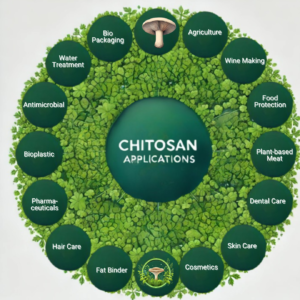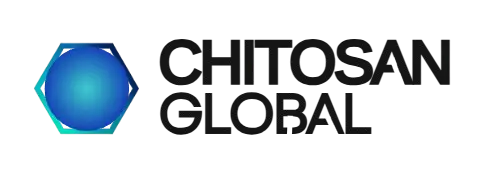

Why Mushroom Chitosan?
Mushroom chitosan is a natural biopolymer extracted from the cell walls of fungi. It’s derived from chitin, a structural component that gives mushrooms their rigidity and form.
Origin and Abundance
- Chitin is the second most abundant natural polysaccharide in nature, after cellulose.
- Most fungi contain 5%-7% chitin in their cell walls.
- Chitin is also found in the exoskeletons of crustaceans (crabs, shrimp, lobsters) and insects. The “crunch” sound when you step on a beetle: chitin.
Pronunciation Guide
- Chitin: Pronounced, “Kite-in” (emphasis on “kite”)
- Deacetylation: Pronounced, “dee-a-SETTLE-ay-shun” (emphasis on “dee”)
- Acetyl: Pronounced, “A-see-tl” (emphasis on “see”)
- Chitosan: Pronounced, “Kite-O-San” (emphasis on “kite”)
Chemical Structure and Properties
Chitosan is obtained through a process called deacetylation of chitin. This involves:
- Removing acetyl groups (CH3OH) from the chitin molecule
- Creating a polymer with free amine groups (NH2)
This chemical transformation gives chitosan its positive charge, differentiating it from its parent compound, chitin.
- Solubility: Unlike chitin, chitosan is soluble in acidic to neutral solutions, making it more versatile for various applications. Our food grade mushroom chitosan oligosaccharide is soluble in water at any pH. It is bactericidal at pH 6.4 and below. To purchase wholesale, click HERE
- Biocompatibility and Biodegradability: Chitosan is known for its excellent biocompatibility and biodegradability. It’s non-toxic and can be broken down by natural biological processes.
Uses and Applications:
Chitosan: A Versatile Biopolymer Revolutionizing Multiple Industries
Chitosan, a remarkable biopolymer derived from chitin, has emerged as a game-changing substance across various sectors. Its unique properties, combined with its biodegradability and non-toxicity, have led to its widespread adoption in numerous applications.
1. Healthcare and Pharmaceuticals
Chitosan’s biocompatibility has made it a cornerstone in medical innovations:
- Wound Healing: Accelerates tissue regeneration and reduces scarring
- Drug Delivery: Enables controlled release of medications, improving efficacy
- Tissue Engineering: Serves as a scaffold for growing new tissues and organs
2. Environmental Protection
In the realm of environmental conservation, chitosan plays a crucial role:
- Water Purification: Effectively binds and removes heavy metals and contaminants
- Soil Remediation: Helps in the cleanup of polluted soils
- Oil Spill Management: Acts as a natural, biodegradable oil dispersant
3. Agriculture
Farmers and agronomists leverage chitosan’s properties to enhance crop production:
- Plant Growth Stimulation: Acts as a natural biostimulant
- Pathogen Resistance: Boosts plants’ natural defense mechanisms
- Seed Coating: Improves seed germination and early plant development
4. Food Industry
Chitosan’s versatility extends to food production and preservation:
- Antimicrobial Food Additive: Prolongs shelf life of perishables
- Edible Films and Coatings: Creates protective layers on fruits and vegetables
- Texture Enhancer: Improves the texture and mouthfeel of various food products
5. Beverage Production
In the alcoholic beverage sector, chitosan serves multiple purposes:
- Clarification Agent: Improves clarity in wines, beers, and spirits
- Stabilizer: Enhances the long-term stability of beverages
- Filtration Aid: Assists in the removal of unwanted particles and microorganisms
6. Dietary Supplements
The health benefits of chitosan have led to its inclusion in various supplements:
- Weight Management: May help reduce fat absorption
- Cholesterol Control: Potentially aids in lowering cholesterol levels
- Digestive Health: Supports gut health and regularity
7. Plastics Industry
As sustainability becomes increasingly important, chitosan offers eco-friendly alternatives:
- Biodegradable Plastics: Serves as a base for creating compostable packaging materials
- Coating for Conventional Plastics: Enhances biodegradability of traditional plastics
- 3D Printing Material: Used in creating biodegradable 3D printed objects
By harnessing the power of this versatile biopolymer, industries are not only improving their products and processes but also contributing to more sustainable practices across the board. As research continues, it’s likely that even more applications for chitosan will be discovered, further cementing its status as a truly revolutionary material.

The wide-ranging applications of chitosan stem from its unique combination of biocompatibility, biodegradability, and non-toxicity. As research continues, it’s likely that even more uses for this versatile compound will be discovered across various industries. There are over 3000 new articles being published about chitosan every year!
Variants:
- Traditional Chitosan: Traditionally sourced from marine crustaceans.
- Mushroom Chitosan: Derived from fungal sources, offering an alternative for those seeking non-animal derived products.
Chitosan’s versatility, biodegradability, and non-toxic nature make it a valuable material across various industries, from healthcare to cosmetics. Its ability to be derived from non-animal sources also makes it an appealing option for vegetarian and vegan-friendly products.
What are the advantages of Mushroom Chitosan?
Mushroom Chitosan is a type of chitosan derived from the cell walls of fungi. It has several advantages over traditional chitosan derived from shellfish, including:
- 1. Vegan and vegetarian-friendly: Mushroom chitosan is an excellent alternative for individuals who avoid animal-based products, such as those who follow a vegan lifestyle.
- 2. Allergen-free: Traditional chitosan is derived from shellfish, which can cause allergic reactions in some people. Mushroom chitosan does not contain any shellfish-derived ingredients, making it an allergen-free option.
- 3. Purer: Mushroom chitosan is often considered to be purer than traditional chitosan because it is derived from a single source, whereas traditional chitosan can be contaminated with other shellfish-related substances.
- 4. Better solubility: Mushroom chitosan is more soluble than traditional chitosan, which makes it easier to incorporate into a variety of applications such as cosmetics, bioplastics, wound care and food.
- 5. Improved bioavailability: Some studies have suggested that mushroom chitosan has higher bioavailability compared to traditional chitosan, which means that it can be absorbed and utilized more effectively by the body.

Overall, mushroom chitosan offers several advantages over traditional chitosan, making it an attractive alternative for individuals and industries looking for a vegan, allergen-free, and more effective chitosan source.
What are the benefits & functions of chitosan in wound care?
Fungal chitosan, derived from sources like oyster mushrooms and Aspergillus niger (from corn fermentation), has several benefits and functions in wound care. Here’s a breakdown:
Chitosan for Wound Care
- Biocompatibility and Biodegradability: Chitosan is highly biocompatible and biodegradable, making it an excellent material for use in medical applications, particularly in wound care. It can be used in dressings without causing significant immune reactions and naturally breaks down in the body.

- Antimicrobial Properties: Chitosan has natural antimicrobial properties which help to prevent wound infections and promote faster healing. This is particularly useful in treating open wounds, where the risk of bacterial and fungal infections is high.

- Promotion of Hemostasis: Chitosan is effective in promoting hemostasis (the stopping of bleeding). This makes chitosan-based dressings ideal for managing bleeding in acute wounds, thus reducing overall wound healing time. The military now uses chitosan to treat battlefield wounds. It has proven itself. 1

- Enhancement of Healing: Chitosan promotes the healing process by enhancing granulation tissue formation and collagen synthesis. This leads to faster and more efficient wound closure. 2

- Non-toxicity: Being derived from natural sources, chitosan is generally non-toxic, which is crucial for any material used in medical treatments, especially those that are in direct contact with open tissues.

Functions of Chitosan in Wound Care
- Wound Dressing Material: Chitosan can be processed into various forms such as gels, films and foams which are used as dressing materials. Chitosan-enhanced dressings are designed to maintain a moist environment around the wound, which is conducive to healing and helps to reduce pain.

- Drug Delivery Medium: Chitosan’s bioadhesive and biofilm-forming properties make it an excellent medium for drug delivery. In wound care, chitosan dressings are impregnated with antimicrobial derivative chitosan or other medications that promote wound healing, providing targeted therapy directly to the wound site.

- Barrier Formation: Chitosan forms a semi-permeable barrier on the wound, protecting it from external contaminants while still allowing it to breathe. This barrier supports the natural wound healing environment, minimizing the risk of infection and promoting faster healing.

- Moisture Absorption: Chitosan has excellent moisture-absorbing properties. This is important in wound care as it helps in absorbing excess wound exudate, which can otherwise hinder the healing process and promote infection.

- Structural Support for Tissue Engineering: In more advanced applications, chitosan can be used as a scaffolding material in tissue engineering. Its structural properties help in supporting new tissue growth, making it suitable for regenerative medicine applications.

Chitosan offers a unique combination of benefits and functions that make it highly suitable for wound care applications. Its ability to promote healing and prevent infection while being biocompatible and biodegradable aligns well with the needs of effective wound management.
What the common forms of chitosan used in wound care?
Chitosan can be processed into several forms for use in wound care, each suited to different types of wounds and treatment goals.
Creating formulations using mushroom or mycelium-based chitosan for wound care products involves carefully balancing the amount of chitosan with other ingredients to achieve the desired properties such as gel strength, flexibility, absorbency, and antimicrobial activity. Here are some of the most common forms and formulations for each type of chitosan-based product used in wound care, including ratios:
- Chitosan Gels: These are hydrogels made from chitosan that are highly absorbent and can maintain a moist environment around the wound. Chitosan gels are particularly useful for burns, ulcers, and other exuding wounds because they can absorb exudate while releasing antimicrobial agents.
- Chitosan Ratio: Generally, 1% to 2% chitosan dissolved in a suitable aqueous acidic solution (such as acetic acid or lactic acid) to solubilize the chitosan.
- Formulation: Add glycerin or a similar humectant to prevent drying out, along with preservatives to enhance shelf life. For enhanced antimicrobial properties, incorporate silver sulfadiazine or other antimicrobial agents.
- Application: Cleanse the wound area, apply the gel directly to the wound, and cover with a secondary dressing if necessary. Change daily or as needed based on the wound’s exudation.
- Suitable Chitosan Type: Chitosan Hydrochloride is often preferred for gel formulations because it is highly soluble in water, which facilitates easier preparation of gels without the need for acidic conditions that might irritate the skin. Carboxymethyl Chitosan is also a good choice due to its enhanced solubility at neutral and slightly basic pH levels, making it more comfortable for wound application.

- Chitosan Films: Thin, flexible films made from chitosan can be applied directly to the wound site. These films form a protective barrier against microbes and help maintain the wound’s moisture balance. They are often used for superficial cuts and abrasions.
- Chitosan Ratio: Typically around 1% to 3% chitosan in a solvent mixture, which can be cast and air-dried to form films.
- Formulation: Plasticizers like polyethylene glycol can be added to improve flexibility. Medications or growth factors can also be incorporated into the film.
- Application: Apply the film directly to the cleansed wound. It can stay on the wound for several days depending on the healing environment and the type of wound.
- Suitable Chitosan Type: Acid-Soluble Chitosan works well for films as it forms strong, flexible films under acidic conditions. However, Carboxymethyl Chitosan can also be used to create films that are more flexible and less pH-dependent, which may be gentler on sensitive wound areas.

- Chitosan Foams: Foams are another common form of chitosan used in wound dressing. They are soft, highly absorbent, and can be used on a variety of wound types, including those with significant exudate. The porous nature of the foam also allows for effective oxygen exchange, which is crucial for wound healing.
- Chitosan Ratio: Around 1% to 4% chitosan, used with a foaming agent or incorporated into a polymeric matrix that can expand and set into a foam structure.
- Formulation: Include a blowing agent for the foam structure and other polymers to enhance structural integrity and absorbency.
- Application: Place the foam dressing over the wound after thorough cleaning. Suitable for high-exudate wounds, change based on saturation.
- Suitable Chitosan Type: Chitosan Hydrochloride is suitable because of its solubility, which facilitates foaming processes. The solubility helps in uniform incorporation of air or gas bubbles, essential for creating a consistent foam structure.

- Chitosan Fibers: These can be woven into bandages or dressings. Chitosan fibers are useful for their structural integrity and versatility. They can be used to pack or cover wounds, providing structural support and promoting healing. Chitosan fiber derived from soldier fly larvae are especially well suited for this type application.
- Chitosan Ratio: Chitosan fibers are typically created from solutions with higher chitosan concentrations, around 2% to 5%.
- Formulation: The fibers may be spun alone or with other biocompatible materials to enhance tensile strength and flexibility.
- Application: Can be used as part of composite dressings or alone, directly applied to the wound, suitable for packing or wrapping.
- Suitable Chitosan Type: Acid-Soluble Chitosan can be used for fibers because it is easily spun into fibers from its acidic solution form. The process involves extruding chitosan through tiny nozzles into a coagulation medium, forming stable, versatile fibers.

- Chitosan Sponges: Similar to foams, chitosan sponges have a highly porous structure that can absorb a large amount of wound exudate. They are particularly useful in managing deep wounds where absorption and maintaining a moist healing environment are critical.
- Chitosan Ratio: About 1% to 3% chitosan, often combined with a cross-linking agent to form a sponge structure.
- Formulation: Cross-linking agents such as glutaraldehyde (use cautiously due to toxicity concerns) or safer alternatives like genipin can be used. Antimicrobial agents can also be added.
- Application: Ideal for deep wounds; place directly into the wound cavity after cleaning. Change based on exudate absorption.
- Suitable Chitosan Type: Chitosan Hydrochloride and Acid-Soluble Chitosan are both effective for sponges due to their ability to form highly absorbent matrix structures when freeze-dried or cross-linked. The choice between these types might depend on the desired rate of biodegradability and mechanical properties.

- Chitosan Particles or Powders: These can be sprinkled directly onto wounds or used to create impregnated dressings. They are beneficial for delivering drugs or other bioactive agents directly into the wound bed.
- Chitosan Ratio: High-purity chitosan ground to fine powders, concentrations can vary widely based on the desired application.
- Formulation: Can be mixed with other powdery substances to enhance adherence, absorbency, or antimicrobial activity.
- Application: Sprinkle directly on the wound after thorough cleaning, covered with a secondary dressing.
- Suitable Chitosan Type: Chitosan Oligosaccharide is an excellent choice for powders and particles because of its lower molecular weight, which allows for quicker solubility and absorption. It also facilitates easier application as a powder due to its finer particle size compared to other forms of chitosan.

Each of these forms leverages the inherent properties of chitosan, such as biocompatibility, antimicrobial activity, and biodegradability, making them highly effective in various aspects of wound care. 3
General Tips for Formulation
- pH adjustment is crucial as chitosan only dissolves in acidic conditions and the final product’s pH should be suitable for application on skin (close to neutral).
- Sterilization methods must be considered to ensure safety without degrading chitosan’s properties.
- Stability and compatibility tests should be performed especially when other active ingredients are included.
These guidelines provide a basic framework for developing chitosan-based wound care products, but detailed formulation development would require experimental validation and regulatory compliance checks, particularly for products intended for medical use.
Additional Considerations for Chitosan Types to Choose
- Carboxymethyl Chitosan generally enhances water solubility and biocompatibility across all forms, and can be particularly beneficial in creating products intended for sensitive or highly absorptive applications.
- Chitosan Hydrochloride offers better solubility in neutral pH conditions compared to traditional acid-soluble chitosan, making it suitable for formulations that require less acidic environments.
The selection of the type of chitosan for each form of wound care product is critical, as the chemical modifications and physical properties of different chitosan derivatives can greatly influence the effectiveness, usability, and comfort of the final product.
Choosing the right type of chitosan is crucial for maximizing the effectiveness of the wound care product, and these choices should be guided by the specific application needs, desired properties of the final product, and the patient’s comfort and safety. Each chitosan derivative brings unique properties that can be leveraged in different forms of wound care products.
Discussion of chitosan in wound care
Chitosan, derived from sources like oyster mushrooms and Aspergillus niger, has emerged as a highly effective material for wound care applications due to its biocompatibility, biodegradability, and intrinsic antimicrobial properties.
Its ability to form films, gels, foams, fibers, sponges, and particles or powders makes it extremely versatile in addressing different types of wounds.
Chitosan facilitates rapid hemostasis, accelerates tissue regeneration by promoting collagen synthesis and granulation tissue formation, and helps manage wound exudates through its superior moisture-absorbing capabilities.

These properties not only enhance the healing process but also reduce the risk of infection, making chitosan a valuable component in advanced wound care solutions.
The use of chitosan in wound care is tailored through various formulations, depending on the specific needs of the wound environment.
Chitosan gels are ideal for keeping wounds moist, while films provide a protective barrier. Foams and sponges are suited for highly exudative wounds, absorbing fluids and maintaining optimal conditions for healing. Fibers can be used to pack or wrap wounds, offering structural support.
Each form of chitosan can be adjusted in terms of viscosity and concentration to optimize its effectiveness, demonstrating the adaptability and the potential of vegetal chitosan in improving wound management practices significantly.
References:
- https://www.ncbi.nlm.nih.gov/pmc/articles/PMC9741326/ A Review on Chitosan and Cellulose Hydrogels for Wound Dressings
- https://www.frontiersin.org/journals/bioengineering-and-biotechnology/articles/10.3389/fbioe.2021.650598/full Chitosan-Based Functional Materials for Skin Wound Repair: Mechanisms and Applications
- https://www.ncbi.nlm.nih.gov/pmc/articles/PMC3188448/ Chitosan preparations for wounds and burns: antimicrobial and wound-healing effects
Book a Free Consultation
If you don’t know what type of chitosan is best for your situation, Book an appointment. we will offer you an initial 30-minute consultation and product quotation at no charge.
